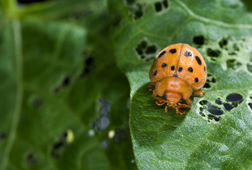This page has been archived and is being provided for reference purposes only. The page is no longer being updated, and therefore, links on the page may be invalid.
Read the magazine story to find out more. |
|
Guarding Corn and Soybeans Against Viral Attack
By Don ComisJune 9, 2006
A “viral strike force” in Wooster, Ohio serves as the “front line” for spotting viral attacks on corn and soybeans in the United States, and on corn worldwide.
The team is jointly supported by the Agricultural Research Service (ARS) and The Ohio State University-Ohio Agricultural Research and Development Center in Wooster. The ARS component comprises the Corn and Soybean Research Unit led by Roy E. Gingery.
Team members are being kept busy because Ohio has experienced an increase in soybean diseases in recent years. The soybean aphid, the first aphid in the United States able to colonize soybeans, was first spotted in July 2000 in Wisconsin. By September, the insects were found in six other states including Ohio. As of 2005, soybean aphids were found in at least 22 states, from Maine to Mississippi and from Delaware to North Dakota.
Besides reducing yields by as much as 50 percent by feeding on plant sap, aphids can transmit viral diseases. To help curb the pests, ARS molecular geneticist Rouf Mian is crossing aphid-resistant soybean lines—recently identified at the University of Illinois and Michigan State University—with high-yielding Ohio lines. His goal is to develop new resistant lines specially adapted to Ohio.
The latest emerging threat to soybeans in Ohio is bean pod mottle virus, which lowers yields and discolors the beans. Bean leaf beetles transmit the virus.
Mian and ARS plant molecular biologist Peg Redinbaugh are working to combine available partial virus resistance with beetle resistance to further slow the spread of the disease. They’ve developed a visual scoring system for rating symptoms of virus-infected plants on a scale of 1 to 5 and a diagnostic test to estimate the levels of virus in plants. These assays give them objective ways to measure the level of resistance to various viral diseases in corn and soybean plants and choose the most promising ones for breeding.
The Wooster researchers will travel anywhere in the world, if invited to help identify a new corn virus.
Read more about the research in the June 2006 issue of Agricultural Research magazine.
ARS is the U.S. Department of Agriculture’s chief scientific research agency.

